 Saint
Anthony is the great apostle of conversion
Saint
Anthony is the great apostle of conversion. He disseminates
the Word of God as an invitation to change life and to hope
for the infinite mercy of God.
Let
us not be unclear. Both for the priest and for the penitent,
divine grace is the main character in "repentance"
and Christian reconciliation. It is that which incites the
preacher to speak of sin, of its gravity, of the necessity
to renounce it, asking for forgiveness; in the same way, it
is not a man who can take us from death to life.
That
which opens the heart to conversion is the omnipotent, merciful
and mysterious love of the Father.
Second premise. We would not expect an element of joy
from a temperament like that of our Saint nor from his concept
of severe an penitential preaching. And yet, it is present.
It can be found where the Thaumaturge exhorts the preacher
to bear with resignation and bliss (a perfect form of Franciscan
joy!) the difficulties he runs into in practising his ministry.
But even in other place, smiles the austere Saint:
when thinks of the eternal reward, fixing eyes of faith on
heaven; when he says that the Church putting a son in the
world in praedicatione vel peccatorum compassione
(in preaching or in compassion for sins) is in anguish,
but forgets the birth pains once it sees a man born in the
world, that is, it overflows with joy and embraces the converted
sinner.
Repentance
(as a virtue and a sacrament) is the dominant topic in the
Sermones of the Doctor evangelicus. It is rare
to find a page on which no mention of this topic is made.
Even when he is stressing to the preachers the sanctity of
life, the constant good example, the expertise of the holy
science, or the liberty and energy of words, he does it with
one main goal in mind: to help the listener make a sincere,
full and long-lasting conversion. The moral-penitential
concept is the basic, founding idea of Anthony's doctrine.
Preaching
has a preserving effect, a therapeutic action of prevention
and maintenance. However, the word "convert!"
is aimed, above all, at those who live in sin and bad habits.
Anthony writes that every type of sinner, including
the arrogant, the jealous, the wrathful, the vainglorious,
the stingy, the gluttonous, and the lascivious must be
roused from spiritual hibernation with pressing urgency
and solicitude because every indulgence has its danger. The
messenger of God should not even have time to greet or respond
to greetings along his way.
The
Saint used the net thrown into the water that catches
every kind of fish as a metaphor for preaching. It
should cause the death of every type of evil in the world,
offer the repentant as a living victim to God and readmit
him into the community of the Church. The missionary must
work harder in those areas where sin rages and ruins.
The Saint says, anticipating Alighieri, that the world is
a dark wood, cold and infested with wild beasts, the worst
of which are gluttony, lasciviousness, stinginess and theft.
In any case, faced with hearts of trachyte or basalt, the
missionary must not spread tears nor announce the Word: that
would be like throwing pearls to swine! The arrogant and the
stingy who, being as ruthless as a press, flatten and squeeze
the poor and miserable, they eat their flesh, they grind their
bones, they are unconvertible and so should be abandoned to
themselves.
Since
sins come in many forms, evangelical preaching must also take
many forms. There are sinners involved in temporal things,
those who have broken their pact with the Lord, those who
grant favours, those who have done no good deeds… The
Word of life must be directed at each of them, in a well-calibrated
way. "And if Jesus falls into sin in one of his members,
with words and oration we must lift him up." The compunction
that will cause an errant soul to break down in tears comes
from preaching no less that from paternal correction and fraternal
compassion.
There
is no reason to be surprised, says Saint Anthony, that the
word of God embitters and upsets, seeing as how it announce
that all the temporal things of the present are passing, that
mortal life is a paltry thing, that death lies in waiting
for everyone ("from which no living man can escape"),
that the sufferings of Hell are surprisingly harsh. Words
that, taken superficially, are unbearable, but which lead
one to repentance.
It is well-known that wicked men want to hear no criticism
of their vice. They dislike the preacher and accuse him
of using outdated abstractions, of being a relic of the past.
Preaching renders stingy men and moneylenders ever more bitter
when it proclaims that the rich man was buried in Hell and
that it is impossible for a camel to pass through the eye
of a needle, in other words, to enter the kingdom of heaven,
and that every worldly splendour and glory will disappear.
All
of the articles of faith that we recite in the Credo are of
interest, but the one most incisive for conversion is that
we calls the mind to Jesus' appearance on Judgement Day and
the sentencing to Hell of sinners hardened by evil. Anthony
seems to be attached to popular catechesis, quite elementary
and rough, but that is the way it is: his experience proves
that it is fear that brings deviants in line. What would
he say today, upon seeing how certain preachers are careful
of avoiding topics which are controversial, upsetting, compromising
and which do not garner much popularity with most people,
such as the end of the world, death, life after death in glory
or castigation?
Father
Samuel Doimi, reading through the Sermones methodically, page
by page, counted 38 mentions in the Gospel of the fact that
conversion must not remain a vague state of undetermined interior
anxiety, but must be externalised in concrete deeds. Conversion
must not be ephemeral, but long-lasting, and substantiated
by perseverance until the end. Not those who begin well, but
those who hang on through difficulties and crosses will reach
eternal blessedness.
Naturally,
the preacher must accompany the converted soul through
the main phases of his new life, and not abandon him in the
unavoidable period of trials provoked by Evil, by weak and
deceitful flesh, and by the world which pesters and fools
him. In the garden of God, the fruit-bearing plants do
not have take care of themselves alone. They also receive
the care of the gardener, who is God with his grace, and they
make use of his helpers, the pastors of souls.
On
various occasions Saint Anthony touches on the "answer"
of the converted soul. This is within the description
of repentance-sacrament, and in its personal form (called,
less appropriately, "private"; although, as the
rescission from God and the Church is a public act, in the
same way repentance involves everyone, through the restored
relationship with God and with the Church). In the attitude
of Mary Magdalene, who, dismayed in mourning, stations herself
next to the empty tomb crying, bowed down, staring, Anthony
recounts the fundamental moments:
- contrition
(or pure pain),
- confession,
- reparations
for the evil done and the good not done.
Elsewhere
(first Sunday of Lent) he asks, "What should contrition
be like? Listen to the psalmist, 'A contrite spirit is
a sacrifice to God; you, oh God, do not disdain a broken and
humiliated heart.' Expressed in this short verse are the compunction
of a spirit that is tormented by its sins, the reconciliation
of the sinner, the universal repentance of his sins, and the
persevering humiliation of the repentant. Because the spirit
of the penitent, when it is pierced and wounded by pain, is
a sacrifice appreciated by God, who makes peace with this
sinner, who, in his turn, reconciles with the Lord."
"Since
contrition must be universal, the heart must be contrite.
Not only "broken" (tritum), but "pounded,
ground" (contritum). Both things are necessary.
Broken: the sinner must break his heart with the hammer-strokes
of contrition, with the sword of pain he must cut it up, one
piece for each mortal sin. Suffering he cries and crying he
suffers (dolendo defleat et deflendo doleat). He
should feel more pain for a single mortal sin committed than
he would feel if he had lost the control of the whole world
and of all the things found in it. In truth, as a result
of mortal sin he lost the Son of God, which is the most sublime
reality, dear and precious to all creatures. His heart must
also be ground, because he must suffer contemporaneously for
all the sins committed, omitted and forgotten." (11,
65-66).
Contrition
must extend to all sins committed, whatever the circumstances,
and to all the good left undone. Sin corrupts:
-
the conscience consenting to evil,
-
the person with the sinful act,
-
the reputation with the scandal it gives rise to.
Contrition,
alone, releases one from all sins, but for it to be real and
operative, it implies confession.
"The
sinner who repents and intends to confess is immediately absolved
of guilt by the Lord, and his eternal punishment is transformed
into a punishment in purgatory. Contrition must be so strong,
like that of Mary Magdalene or the good thief, that in case
of death it will conduct us straight to heaven. When we
confess to a priest, he imposes a temporal punishment, which
is a transformation of the punishment of purgatory that we
have incurred. Followed with diligence, this will start us
on the road to eternal glory. This is how God and the priest
release us from and absolve us of our sins." (1, 239).
That
which Saint Anthony, too, calls the second life raft after
the shipwreck is the explanation of sins made by the priest.
According to the sermons, changing the perspectives and the
tone of exposition, emphasis can be placed on one or another
aspect of confession.
Confession
has four enemies that, turned around, become four
friends:
-
the love for sin (is detestation),
- the
shame to denounce it (the serene courage to tell the truth),
- the
fear of repentance (the courage to taken on responsibilities
and consequences),
-
the desperation to obtain pardon (the faith in divine mercy).
In
the meantime, centuries have passed, and the weight of
repentance has changed. In Saint Anthony's time, it was
very severe, the penalty of retaliation or, in the style of
Dante, of making the punishment fit the crime.
Therefore,
humility is necessary. If one is not ashamed to cause trouble,
why should he blush when his deeds are unmasked, especially
since the confessor is gravely bound to silence. Certainly,
confessing well requires effort:
-
preparation,
- accusation,
- shame...
More
positive values also emerge, such as:
-
the hope for a liberating pardon,
- hatred
for evil,
- force
of purpose,
- the
obligation to obey the confessor ...
The
Saint twice cites the famous mnemo-technical verse enumerating
the circumstances of sins: who, what, where, through whom,
to whom, in what way, when. Circumstances which should
be applied to the confession of every mortal sin, such as
hate, gossip and slander, hypocrisy and falsity, lasciviousness,
pride, stinginess and usury, negligence of duties and so on.
Confess
well, confess often. At that time, Canon 21 of the 4th
Lateran Council (1215) was already in act, prescribing annual
confession. Anthony deplored the numerous believers who followed
this minimum, "If you drink the poison of sin every day,
every day you must accept the antidote of confession."
(1, 467) A great expert of consciences was speaking!
He
also spent time on the duty of discretio (discretion,
discernment, balance) especially on the part the priest.
Confession looks like a penitent, but even more it has the
traits, the religious atmosphere, the moral sentiment and
the style that the priest gives it. Absolution does not
work in a mechanical way. Its efficacy also depends on the
disposition of the faithful, especially on the seriousness
of his resolution.
"Satisfaction"
carries less weight today than it did in the Middle Ages.
It is the third stage in sacramental repentance. Before the
rise of Scholasticism (in the second half of the 13th century)
there was a high level of severity in this field. Rigaldi,
the author of an ancient legend about Saint Anthony, tells
that the Thaumaturge ordered 12 pilgrimages to Rome, on foot,
for a converted latro et raptor (brigand and robber).
As
we are poor sinners ("he who says he is without sin
is a liar": 1st letter of John, 1,10), our earthly
state is of incurable fragility, of inexhaustible repentance
and incessant confession and conversion, and reparation. It
is not enough to repent, it is necessary, within the limits
of possibility, to restore the compromised equilibrium, and
damage done. Saint Anthony insists on the expiatory
power of prayer to God, charity to one's neighbour and
fasting.
Satisfaction
(called today, simply, but inaccurately, penitence) must
be in proportion to the sin, so that the punishment corresponds
to the sin with which we have stained ourselves. Certainly,
this only has value if it is done in the spirit of faith.
Then it is Jesus who immolates himself in us, who repairs
together with us, and it is his omnipotent grace that brings
back order and harmony where there was the devastating evil
deed.
"We,
therefore, who call ourselves Christians with the name of
Christ, unanimously with devoted minds, pray to the same Son
of God, Jesus Christ, and, with insistence, we ask that
he allow us to pass from the spirit of contrition to the desert
of confession so that we can receive forgiveness for our iniquities
and, renewed and purified, we deserve to enjoy the joys of
his resurrection and to take our place in the glory of
eternal beatitude, with the help of his grace. May he have
honour and glory in the centuries. Amen!"

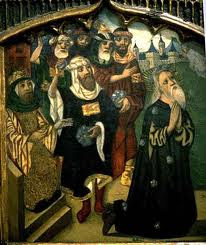











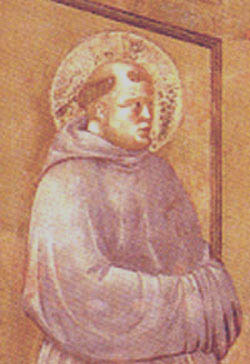
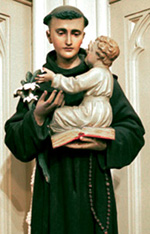
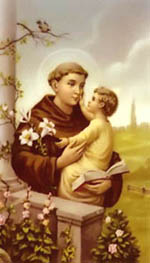
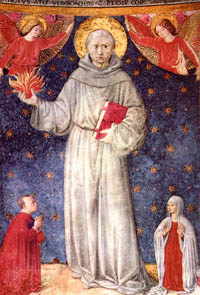







 From
the Basilica's south door (or from the Noviciate Courtyard)
you can reach the Magnolia Courtyard,
so-called because of the "Magnolia grandiflora"
which was planted in the centre in 1810. The actual
courtyard originates from 1433. Here, as in the other
courtyards, there are tombs, monuments, plaques and
epigraphs, too much to describe in detail here.
From
the Basilica's south door (or from the Noviciate Courtyard)
you can reach the Magnolia Courtyard,
so-called because of the "Magnolia grandiflora"
which was planted in the centre in 1810. The actual
courtyard originates from 1433. Here, as in the other
courtyards, there are tombs, monuments, plaques and
epigraphs, too much to describe in detail here. Exiting
the shop or the Magnolia Courtyard you can enter the
General's Courtyard (built in 1435,
in the Gothic style, work of Cristoforo da Bolzano).
It has this name because the accommodations reserved
for the General of the Order (as well as other religious
authorities), during visits to the Basilica and its
religious community, open onto this courtyard. From
this courtyard you can enter the prestigious Anthonian
library.
Exiting
the shop or the Magnolia Courtyard you can enter the
General's Courtyard (built in 1435,
in the Gothic style, work of Cristoforo da Bolzano).
It has this name because the accommodations reserved
for the General of the Order (as well as other religious
authorities), during visits to the Basilica and its
religious community, open onto this courtyard. From
this courtyard you can enter the prestigious Anthonian
library. You
can get here either through the Anthonian Exhibition
or the Magnolia Courtyard. This is a majestic Gothic
courtyard dating back to the latter half of the fifteenth
century. The adjacent rooms are the seats of various
organisations: the Institute of Religious Science,
the
You
can get here either through the Anthonian Exhibition
or the Magnolia Courtyard. This is a majestic Gothic
courtyard dating back to the latter half of the fifteenth
century. The adjacent rooms are the seats of various
organisations: the Institute of Religious Science,
the  This
chapel was built by Raimondino Lupi di Soragna (Parma)
in the latter half of the fourteenth century as
a burial chapel for himself and his family who had retired
in Padua. It was completed by his relative Bonifacio
Lupi. Just like St. James' Chapel in the Basilica, the
oratory was completely frescoed by Altichiero da
Zevio and his aides. Art lovers must not miss this
splendid occasion. The entrance fee is very modest and
there are detailed guides available.
This
chapel was built by Raimondino Lupi di Soragna (Parma)
in the latter half of the fourteenth century as
a burial chapel for himself and his family who had retired
in Padua. It was completed by his relative Bonifacio
Lupi. Just like St. James' Chapel in the Basilica, the
oratory was completely frescoed by Altichiero da
Zevio and his aides. Art lovers must not miss this
splendid occasion. The entrance fee is very modest and
there are detailed guides available. This
term originates from Venetian tradition. It refers to
the seat of the Arch-confraternity of St. Anthony,
which boasts of a centuries long history and which is
still an active charitable society.
This
term originates from Venetian tradition. It refers to
the seat of the Arch-confraternity of St. Anthony,
which boasts of a centuries long history and which is
still an active charitable society.  In
the Basilica, in the Chapel of the Most Holy, there
is the Tomb of Erasmo da Narni (nicknamed Gattamelata,
1443) Here we can admire the renowned equestrian
monument, a bronze masterpiece by Donatello
(1453), which uses, for the first time in modern history,
the ancient theme of the equestrian monument. Funereal
symbols, engraved onto the cenotaph, ensure that the
memory of the unyielding leader remains vivid.
In
the Basilica, in the Chapel of the Most Holy, there
is the Tomb of Erasmo da Narni (nicknamed Gattamelata,
1443) Here we can admire the renowned equestrian
monument, a bronze masterpiece by Donatello
(1453), which uses, for the first time in modern history,
the ancient theme of the equestrian monument. Funereal
symbols, engraved onto the cenotaph, ensure that the
memory of the unyielding leader remains vivid.  Saint
Anthony is the great apostle of conversion. He disseminates
the Word of God as an invitation to change life and to hope
for the infinite mercy of God.
Saint
Anthony is the great apostle of conversion. He disseminates
the Word of God as an invitation to change life and to hope
for the infinite mercy of God.
 Anthony
was in love with Jesus Christ and, like Francis, above all,
was enchanted by the mystery of Christmas and the Passion. In
the Babe of Bethlehem, Anthony contemplated the Wisdom that
becomes a stutterer, the Power that becomes weakness, the Majesty
that becomes condescension, the Immense that becomes a child
and the King of Angels who lowers himself to a manger.
Anthony
was in love with Jesus Christ and, like Francis, above all,
was enchanted by the mystery of Christmas and the Passion. In
the Babe of Bethlehem, Anthony contemplated the Wisdom that
becomes a stutterer, the Power that becomes weakness, the Majesty
that becomes condescension, the Immense that becomes a child
and the King of Angels who lowers himself to a manger. Passing
from the cloistered environment of the rich Portuguese monasteries
to the "vast cloister of the world," Anthony completely
embraced the poverty of the Minorites. He experienced the
trusting abandon in the hands of Providence when he departed
for Africa with only his cassock, without money, in total human
uncertainty and total certainty of assistance from the heavenly
Father.
Passing
from the cloistered environment of the rich Portuguese monasteries
to the "vast cloister of the world," Anthony completely
embraced the poverty of the Minorites. He experienced the
trusting abandon in the hands of Providence when he departed
for Africa with only his cassock, without money, in total human
uncertainty and total certainty of assistance from the heavenly
Father. The particular Franciscanism of Anthony is a rich field for
investigation. He was trained in quite different environments,
he had a different (which is not a synonym for adverse) temperament
and spiritual outlook for being a satellite of Francis, being
to him like the moon is to the sun. Even the first companions
entered into the group of "Penitents of Assisi" as
adults; but they shared years of life with Francis, they felt
his influence, they were able to develop their creativity
and charisma, in harmony with their guide, since they participated
in the same evangelical adventure.
The particular Franciscanism of Anthony is a rich field for
investigation. He was trained in quite different environments,
he had a different (which is not a synonym for adverse) temperament
and spiritual outlook for being a satellite of Francis, being
to him like the moon is to the sun. Even the first companions
entered into the group of "Penitents of Assisi" as
adults; but they shared years of life with Francis, they felt
his influence, they were able to develop their creativity
and charisma, in harmony with their guide, since they participated
in the same evangelical adventure. Saint
Anthony was a Franciscan. Obviously, because in 1220
he left the Augustinian Order and joined the followers of Francis
of Assisi, becoming a "minor monk." Son and disciple
of Francis, but broadly speaking, toned down, original.
Saint
Anthony was a Franciscan. Obviously, because in 1220
he left the Augustinian Order and joined the followers of Francis
of Assisi, becoming a "minor monk." Son and disciple
of Francis, but broadly speaking, toned down, original. Saint
Anthony is the most well-known and loved saint in the world.
Millions of pilgrims and faithful, from all round the world,
visit his Basilica in Padua every year. There isn't a church
in the world which doesn't have an altar, painting, statue,
fresco, or niche dedicated to St. Anthony, not to mention the
countless little statues and small holy pictures in people's
homes.
Saint
Anthony is the most well-known and loved saint in the world.
Millions of pilgrims and faithful, from all round the world,
visit his Basilica in Padua every year. There isn't a church
in the world which doesn't have an altar, painting, statue,
fresco, or niche dedicated to St. Anthony, not to mention the
countless little statues and small holy pictures in people's
homes.
 Saint
Anthony was particularly fond of children. Among his miracles,
whilst he was alive, more than one involved children.
Saint
Anthony was particularly fond of children. Among his miracles,
whilst he was alive, more than one involved children.